Consumer Decision Making Process: B2C, B2B, and Digital Impact
VerifiedAdded on 2020/12/31
|9
|2422
|242
Report
AI Summary
This report provides a comprehensive overview of the consumer decision-making process, contrasting the B2C and B2B approaches. It explores the key differences between these models, highlighting how market research strategies differ in each context. The report examines the influence of personality, self-motivation, and customer perception on decision-making, alongside an analysis of behavioral and cognitive approaches to consumer learning. Furthermore, it delves into the impact of cultural and economic factors on consumer behavior. The assignment also evaluates how organizations leverage their understanding of buyer behavior to influence decision-making in both B2C and B2B settings, with a specific focus on the use of digital audience research, including social media and company websites, to understand and shape consumer choices. The report concludes by summarizing the key insights and findings related to consumer behavior and decision-making strategies.
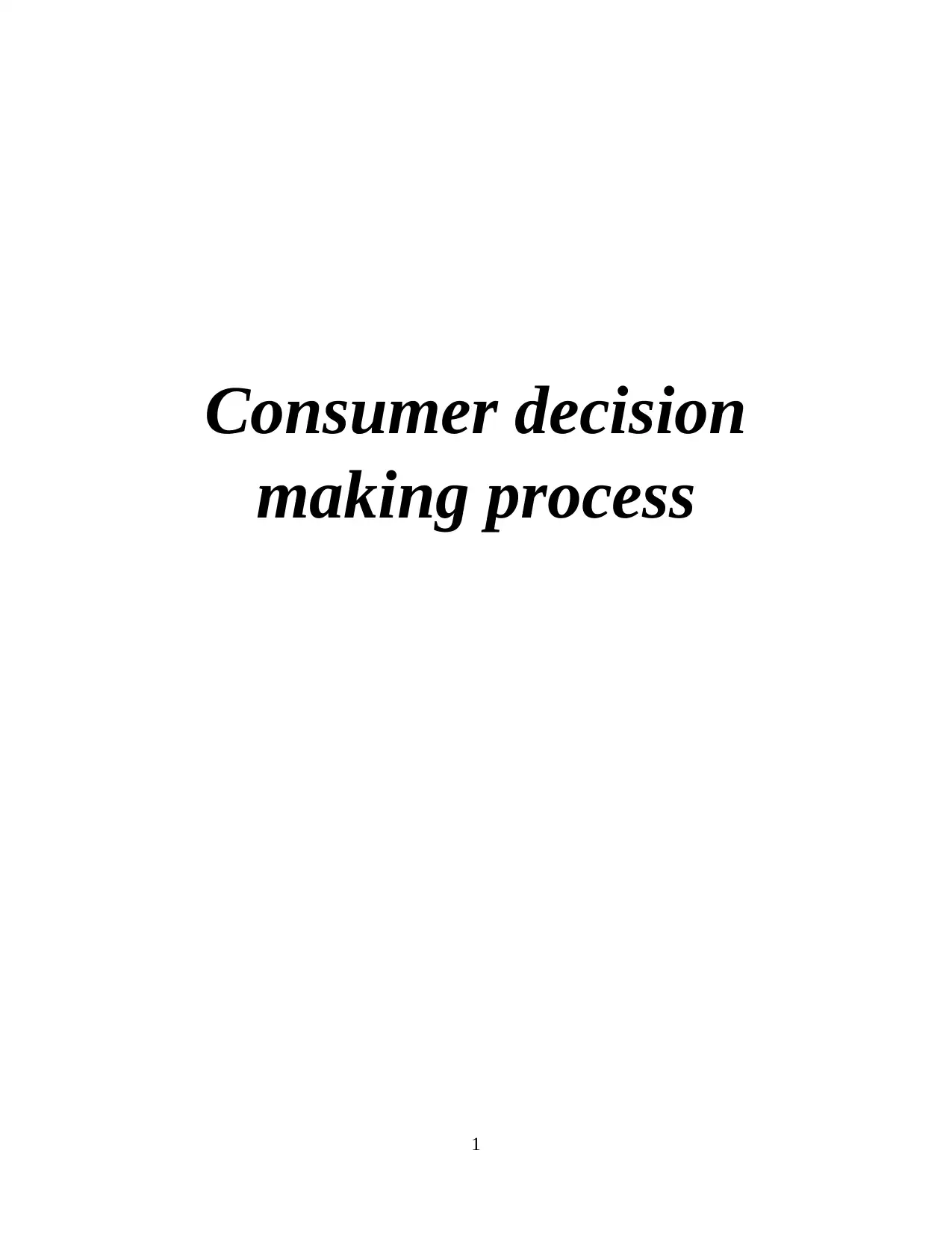
Consumer decision
making process
1
making process
1
Paraphrase This Document
Need a fresh take? Get an instant paraphrase of this document with our AI Paraphraser
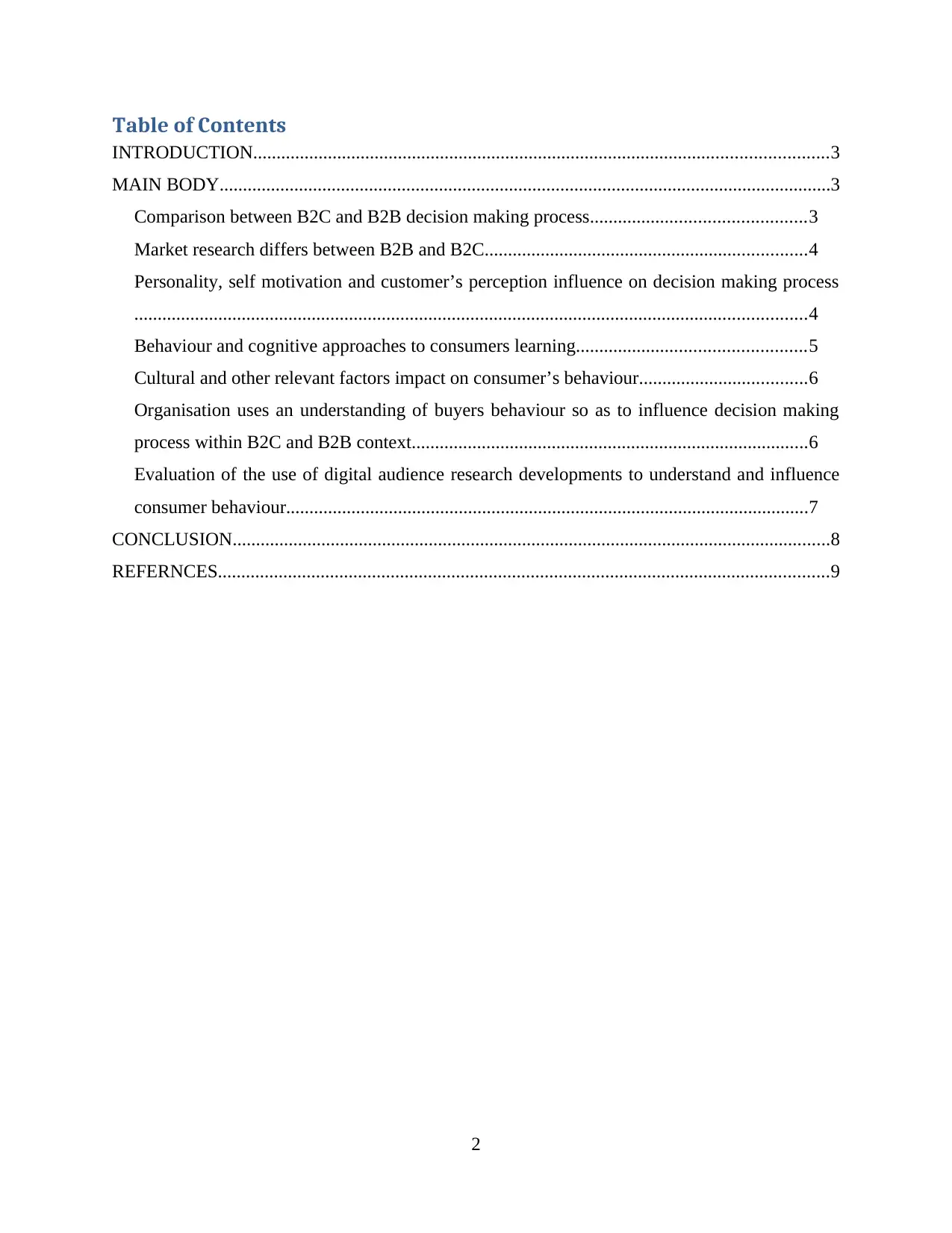
Table of Contents
INTRODUCTION...........................................................................................................................3
MAIN BODY...................................................................................................................................3
Comparison between B2C and B2B decision making process..............................................3
Market research differs between B2B and B2C.....................................................................4
Personality, self motivation and customer’s perception influence on decision making process
................................................................................................................................................4
Behaviour and cognitive approaches to consumers learning.................................................5
Cultural and other relevant factors impact on consumer’s behaviour....................................6
Organisation uses an understanding of buyers behaviour so as to influence decision making
process within B2C and B2B context.....................................................................................6
Evaluation of the use of digital audience research developments to understand and influence
consumer behaviour................................................................................................................7
CONCLUSION................................................................................................................................8
REFERNCES...................................................................................................................................9
2
INTRODUCTION...........................................................................................................................3
MAIN BODY...................................................................................................................................3
Comparison between B2C and B2B decision making process..............................................3
Market research differs between B2B and B2C.....................................................................4
Personality, self motivation and customer’s perception influence on decision making process
................................................................................................................................................4
Behaviour and cognitive approaches to consumers learning.................................................5
Cultural and other relevant factors impact on consumer’s behaviour....................................6
Organisation uses an understanding of buyers behaviour so as to influence decision making
process within B2C and B2B context.....................................................................................6
Evaluation of the use of digital audience research developments to understand and influence
consumer behaviour................................................................................................................7
CONCLUSION................................................................................................................................8
REFERNCES...................................................................................................................................9
2
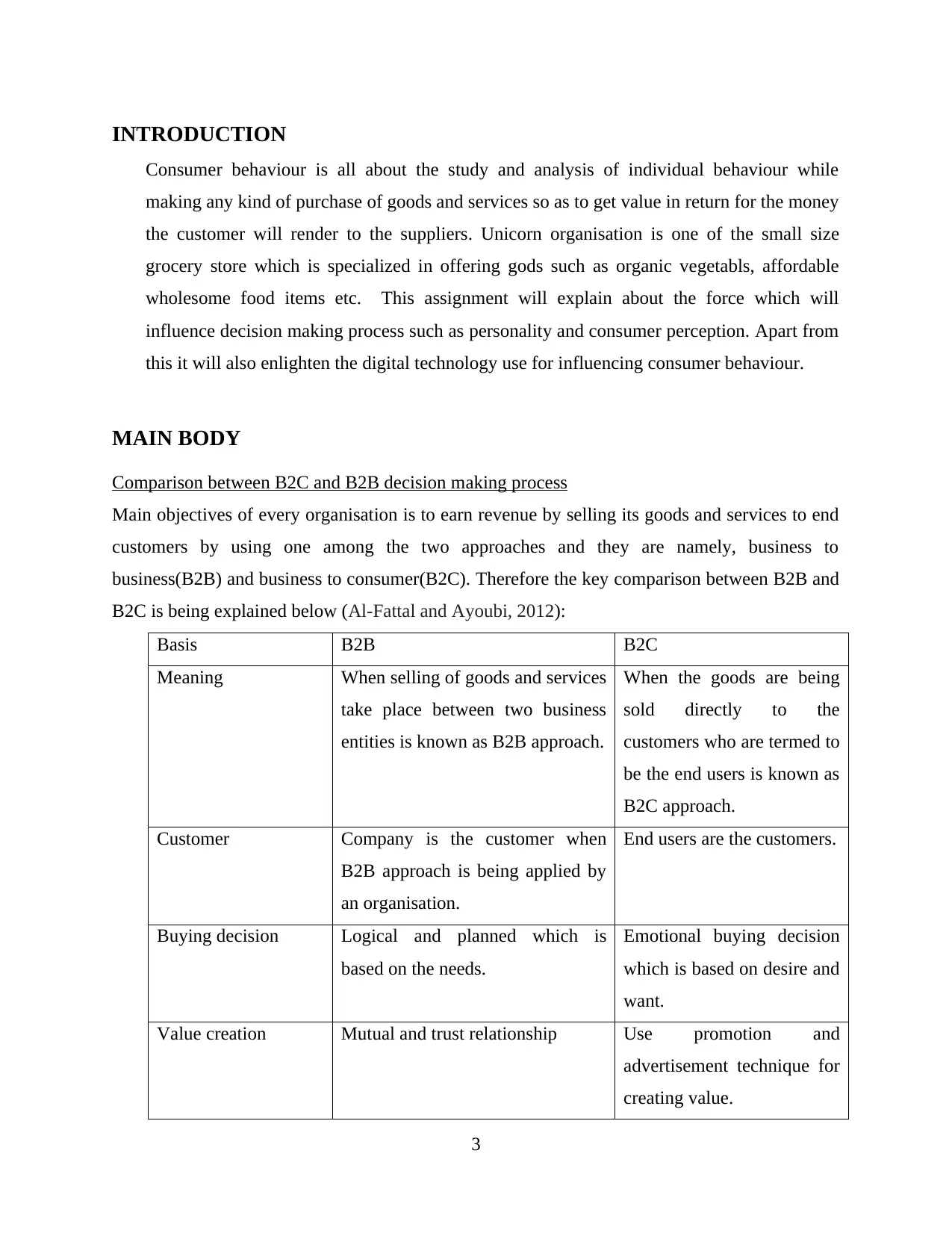
INTRODUCTION
Consumer behaviour is all about the study and analysis of individual behaviour while
making any kind of purchase of goods and services so as to get value in return for the money
the customer will render to the suppliers. Unicorn organisation is one of the small size
grocery store which is specialized in offering gods such as organic vegetabls, affordable
wholesome food items etc. This assignment will explain about the force which will
influence decision making process such as personality and consumer perception. Apart from
this it will also enlighten the digital technology use for influencing consumer behaviour.
MAIN BODY
Comparison between B2C and B2B decision making process
Main objectives of every organisation is to earn revenue by selling its goods and services to end
customers by using one among the two approaches and they are namely, business to
business(B2B) and business to consumer(B2C). Therefore the key comparison between B2B and
B2C is being explained below (Al-Fattal and Ayoubi, 2012):
Basis B2B B2C
Meaning When selling of goods and services
take place between two business
entities is known as B2B approach.
When the goods are being
sold directly to the
customers who are termed to
be the end users is known as
B2C approach.
Customer Company is the customer when
B2B approach is being applied by
an organisation.
End users are the customers.
Buying decision Logical and planned which is
based on the needs.
Emotional buying decision
which is based on desire and
want.
Value creation Mutual and trust relationship Use promotion and
advertisement technique for
creating value.
3
Consumer behaviour is all about the study and analysis of individual behaviour while
making any kind of purchase of goods and services so as to get value in return for the money
the customer will render to the suppliers. Unicorn organisation is one of the small size
grocery store which is specialized in offering gods such as organic vegetabls, affordable
wholesome food items etc. This assignment will explain about the force which will
influence decision making process such as personality and consumer perception. Apart from
this it will also enlighten the digital technology use for influencing consumer behaviour.
MAIN BODY
Comparison between B2C and B2B decision making process
Main objectives of every organisation is to earn revenue by selling its goods and services to end
customers by using one among the two approaches and they are namely, business to
business(B2B) and business to consumer(B2C). Therefore the key comparison between B2B and
B2C is being explained below (Al-Fattal and Ayoubi, 2012):
Basis B2B B2C
Meaning When selling of goods and services
take place between two business
entities is known as B2B approach.
When the goods are being
sold directly to the
customers who are termed to
be the end users is known as
B2C approach.
Customer Company is the customer when
B2B approach is being applied by
an organisation.
End users are the customers.
Buying decision Logical and planned which is
based on the needs.
Emotional buying decision
which is based on desire and
want.
Value creation Mutual and trust relationship Use promotion and
advertisement technique for
creating value.
3
⊘ This is a preview!⊘
Do you want full access?
Subscribe today to unlock all pages.

Trusted by 1+ million students worldwide
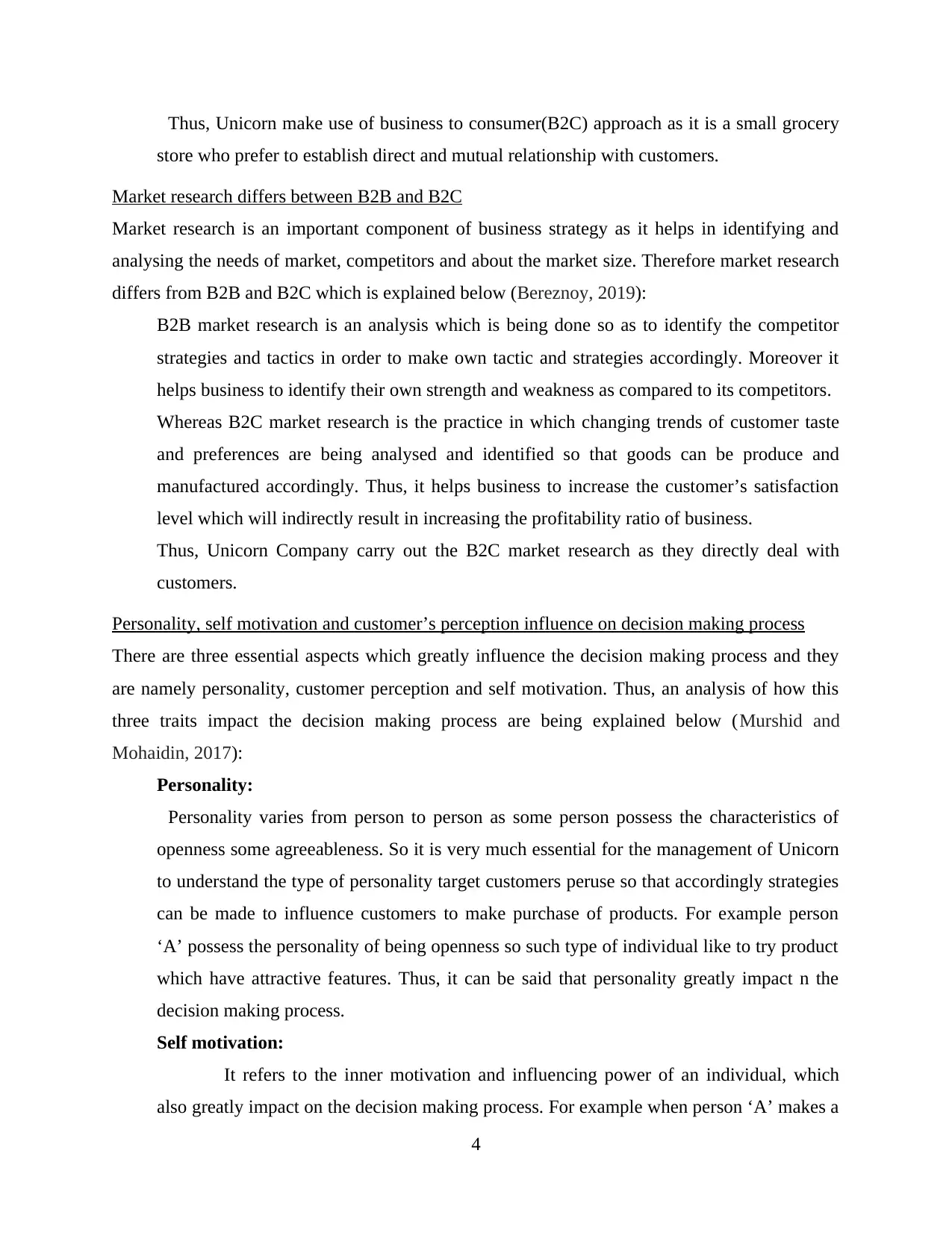
Thus, Unicorn make use of business to consumer(B2C) approach as it is a small grocery
store who prefer to establish direct and mutual relationship with customers.
Market research differs between B2B and B2C
Market research is an important component of business strategy as it helps in identifying and
analysing the needs of market, competitors and about the market size. Therefore market research
differs from B2B and B2C which is explained below (Bereznoy, 2019):
B2B market research is an analysis which is being done so as to identify the competitor
strategies and tactics in order to make own tactic and strategies accordingly. Moreover it
helps business to identify their own strength and weakness as compared to its competitors.
Whereas B2C market research is the practice in which changing trends of customer taste
and preferences are being analysed and identified so that goods can be produce and
manufactured accordingly. Thus, it helps business to increase the customer’s satisfaction
level which will indirectly result in increasing the profitability ratio of business.
Thus, Unicorn Company carry out the B2C market research as they directly deal with
customers.
Personality, self motivation and customer’s perception influence on decision making process
There are three essential aspects which greatly influence the decision making process and they
are namely personality, customer perception and self motivation. Thus, an analysis of how this
three traits impact the decision making process are being explained below (Murshid and
Mohaidin, 2017):
Personality:
Personality varies from person to person as some person possess the characteristics of
openness some agreeableness. So it is very much essential for the management of Unicorn
to understand the type of personality target customers peruse so that accordingly strategies
can be made to influence customers to make purchase of products. For example person
‘A’ possess the personality of being openness so such type of individual like to try product
which have attractive features. Thus, it can be said that personality greatly impact n the
decision making process.
Self motivation:
It refers to the inner motivation and influencing power of an individual, which
also greatly impact on the decision making process. For example when person ‘A’ makes a
4
store who prefer to establish direct and mutual relationship with customers.
Market research differs between B2B and B2C
Market research is an important component of business strategy as it helps in identifying and
analysing the needs of market, competitors and about the market size. Therefore market research
differs from B2B and B2C which is explained below (Bereznoy, 2019):
B2B market research is an analysis which is being done so as to identify the competitor
strategies and tactics in order to make own tactic and strategies accordingly. Moreover it
helps business to identify their own strength and weakness as compared to its competitors.
Whereas B2C market research is the practice in which changing trends of customer taste
and preferences are being analysed and identified so that goods can be produce and
manufactured accordingly. Thus, it helps business to increase the customer’s satisfaction
level which will indirectly result in increasing the profitability ratio of business.
Thus, Unicorn Company carry out the B2C market research as they directly deal with
customers.
Personality, self motivation and customer’s perception influence on decision making process
There are three essential aspects which greatly influence the decision making process and they
are namely personality, customer perception and self motivation. Thus, an analysis of how this
three traits impact the decision making process are being explained below (Murshid and
Mohaidin, 2017):
Personality:
Personality varies from person to person as some person possess the characteristics of
openness some agreeableness. So it is very much essential for the management of Unicorn
to understand the type of personality target customers peruse so that accordingly strategies
can be made to influence customers to make purchase of products. For example person
‘A’ possess the personality of being openness so such type of individual like to try product
which have attractive features. Thus, it can be said that personality greatly impact n the
decision making process.
Self motivation:
It refers to the inner motivation and influencing power of an individual, which
also greatly impact on the decision making process. For example when person ‘A’ makes a
4
Paraphrase This Document
Need a fresh take? Get an instant paraphrase of this document with our AI Paraphraser
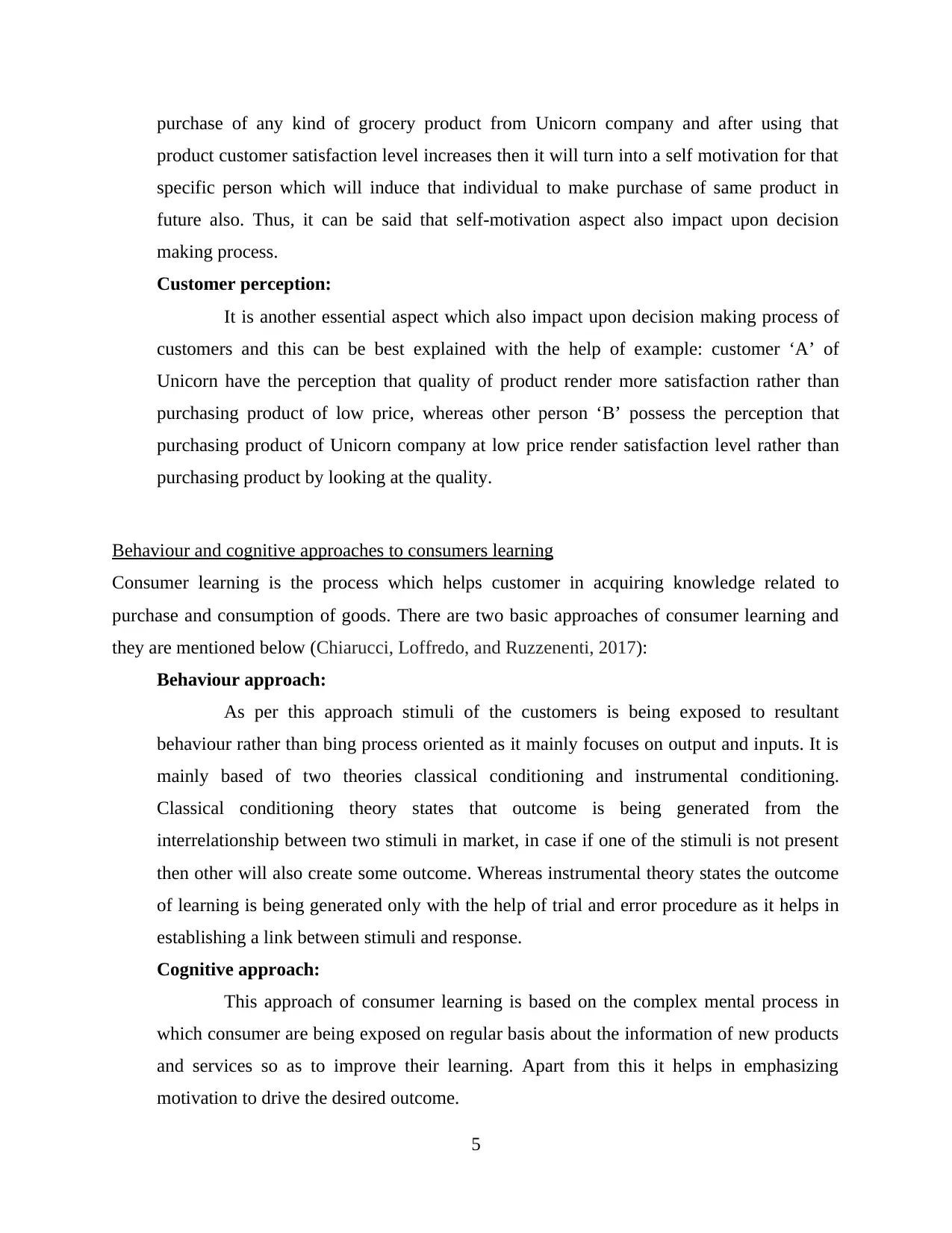
purchase of any kind of grocery product from Unicorn company and after using that
product customer satisfaction level increases then it will turn into a self motivation for that
specific person which will induce that individual to make purchase of same product in
future also. Thus, it can be said that self-motivation aspect also impact upon decision
making process.
Customer perception:
It is another essential aspect which also impact upon decision making process of
customers and this can be best explained with the help of example: customer ‘A’ of
Unicorn have the perception that quality of product render more satisfaction rather than
purchasing product of low price, whereas other person ‘B’ possess the perception that
purchasing product of Unicorn company at low price render satisfaction level rather than
purchasing product by looking at the quality.
Behaviour and cognitive approaches to consumers learning
Consumer learning is the process which helps customer in acquiring knowledge related to
purchase and consumption of goods. There are two basic approaches of consumer learning and
they are mentioned below (Chiarucci, Loffredo, and Ruzzenenti, 2017):
Behaviour approach:
As per this approach stimuli of the customers is being exposed to resultant
behaviour rather than bing process oriented as it mainly focuses on output and inputs. It is
mainly based of two theories classical conditioning and instrumental conditioning.
Classical conditioning theory states that outcome is being generated from the
interrelationship between two stimuli in market, in case if one of the stimuli is not present
then other will also create some outcome. Whereas instrumental theory states the outcome
of learning is being generated only with the help of trial and error procedure as it helps in
establishing a link between stimuli and response.
Cognitive approach:
This approach of consumer learning is based on the complex mental process in
which consumer are being exposed on regular basis about the information of new products
and services so as to improve their learning. Apart from this it helps in emphasizing
motivation to drive the desired outcome.
5
product customer satisfaction level increases then it will turn into a self motivation for that
specific person which will induce that individual to make purchase of same product in
future also. Thus, it can be said that self-motivation aspect also impact upon decision
making process.
Customer perception:
It is another essential aspect which also impact upon decision making process of
customers and this can be best explained with the help of example: customer ‘A’ of
Unicorn have the perception that quality of product render more satisfaction rather than
purchasing product of low price, whereas other person ‘B’ possess the perception that
purchasing product of Unicorn company at low price render satisfaction level rather than
purchasing product by looking at the quality.
Behaviour and cognitive approaches to consumers learning
Consumer learning is the process which helps customer in acquiring knowledge related to
purchase and consumption of goods. There are two basic approaches of consumer learning and
they are mentioned below (Chiarucci, Loffredo, and Ruzzenenti, 2017):
Behaviour approach:
As per this approach stimuli of the customers is being exposed to resultant
behaviour rather than bing process oriented as it mainly focuses on output and inputs. It is
mainly based of two theories classical conditioning and instrumental conditioning.
Classical conditioning theory states that outcome is being generated from the
interrelationship between two stimuli in market, in case if one of the stimuli is not present
then other will also create some outcome. Whereas instrumental theory states the outcome
of learning is being generated only with the help of trial and error procedure as it helps in
establishing a link between stimuli and response.
Cognitive approach:
This approach of consumer learning is based on the complex mental process in
which consumer are being exposed on regular basis about the information of new products
and services so as to improve their learning. Apart from this it helps in emphasizing
motivation to drive the desired outcome.
5
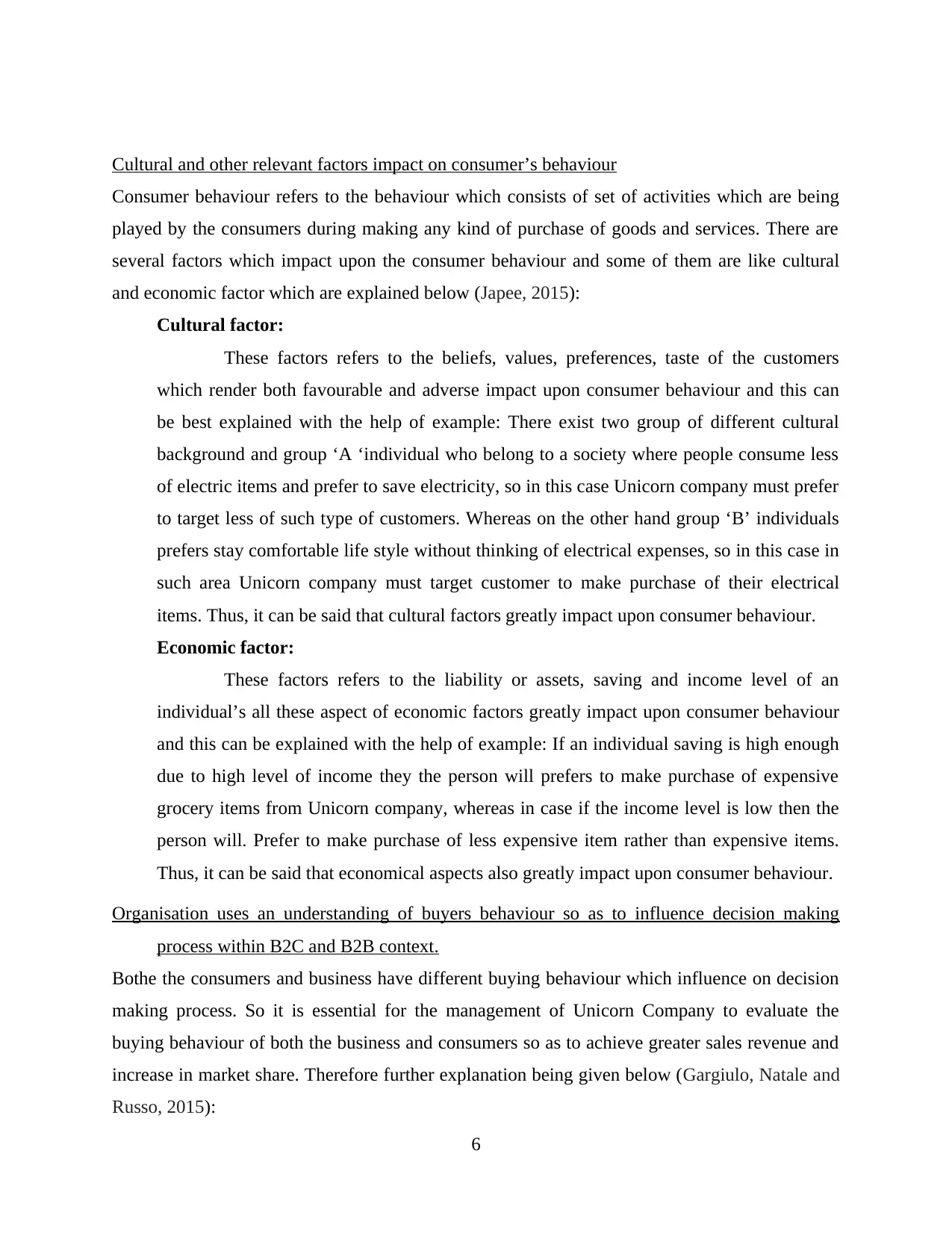
Cultural and other relevant factors impact on consumer’s behaviour
Consumer behaviour refers to the behaviour which consists of set of activities which are being
played by the consumers during making any kind of purchase of goods and services. There are
several factors which impact upon the consumer behaviour and some of them are like cultural
and economic factor which are explained below (Japee, 2015):
Cultural factor:
These factors refers to the beliefs, values, preferences, taste of the customers
which render both favourable and adverse impact upon consumer behaviour and this can
be best explained with the help of example: There exist two group of different cultural
background and group ‘A ‘individual who belong to a society where people consume less
of electric items and prefer to save electricity, so in this case Unicorn company must prefer
to target less of such type of customers. Whereas on the other hand group ‘B’ individuals
prefers stay comfortable life style without thinking of electrical expenses, so in this case in
such area Unicorn company must target customer to make purchase of their electrical
items. Thus, it can be said that cultural factors greatly impact upon consumer behaviour.
Economic factor:
These factors refers to the liability or assets, saving and income level of an
individual’s all these aspect of economic factors greatly impact upon consumer behaviour
and this can be explained with the help of example: If an individual saving is high enough
due to high level of income they the person will prefers to make purchase of expensive
grocery items from Unicorn company, whereas in case if the income level is low then the
person will. Prefer to make purchase of less expensive item rather than expensive items.
Thus, it can be said that economical aspects also greatly impact upon consumer behaviour.
Organisation uses an understanding of buyers behaviour so as to influence decision making
process within B2C and B2B context.
Bothe the consumers and business have different buying behaviour which influence on decision
making process. So it is essential for the management of Unicorn Company to evaluate the
buying behaviour of both the business and consumers so as to achieve greater sales revenue and
increase in market share. Therefore further explanation being given below (Gargiulo, Natale and
Russo, 2015):
6
Consumer behaviour refers to the behaviour which consists of set of activities which are being
played by the consumers during making any kind of purchase of goods and services. There are
several factors which impact upon the consumer behaviour and some of them are like cultural
and economic factor which are explained below (Japee, 2015):
Cultural factor:
These factors refers to the beliefs, values, preferences, taste of the customers
which render both favourable and adverse impact upon consumer behaviour and this can
be best explained with the help of example: There exist two group of different cultural
background and group ‘A ‘individual who belong to a society where people consume less
of electric items and prefer to save electricity, so in this case Unicorn company must prefer
to target less of such type of customers. Whereas on the other hand group ‘B’ individuals
prefers stay comfortable life style without thinking of electrical expenses, so in this case in
such area Unicorn company must target customer to make purchase of their electrical
items. Thus, it can be said that cultural factors greatly impact upon consumer behaviour.
Economic factor:
These factors refers to the liability or assets, saving and income level of an
individual’s all these aspect of economic factors greatly impact upon consumer behaviour
and this can be explained with the help of example: If an individual saving is high enough
due to high level of income they the person will prefers to make purchase of expensive
grocery items from Unicorn company, whereas in case if the income level is low then the
person will. Prefer to make purchase of less expensive item rather than expensive items.
Thus, it can be said that economical aspects also greatly impact upon consumer behaviour.
Organisation uses an understanding of buyers behaviour so as to influence decision making
process within B2C and B2B context.
Bothe the consumers and business have different buying behaviour which influence on decision
making process. So it is essential for the management of Unicorn Company to evaluate the
buying behaviour of both the business and consumers so as to achieve greater sales revenue and
increase in market share. Therefore further explanation being given below (Gargiulo, Natale and
Russo, 2015):
6
⊘ This is a preview!⊘
Do you want full access?
Subscribe today to unlock all pages.

Trusted by 1+ million students worldwide
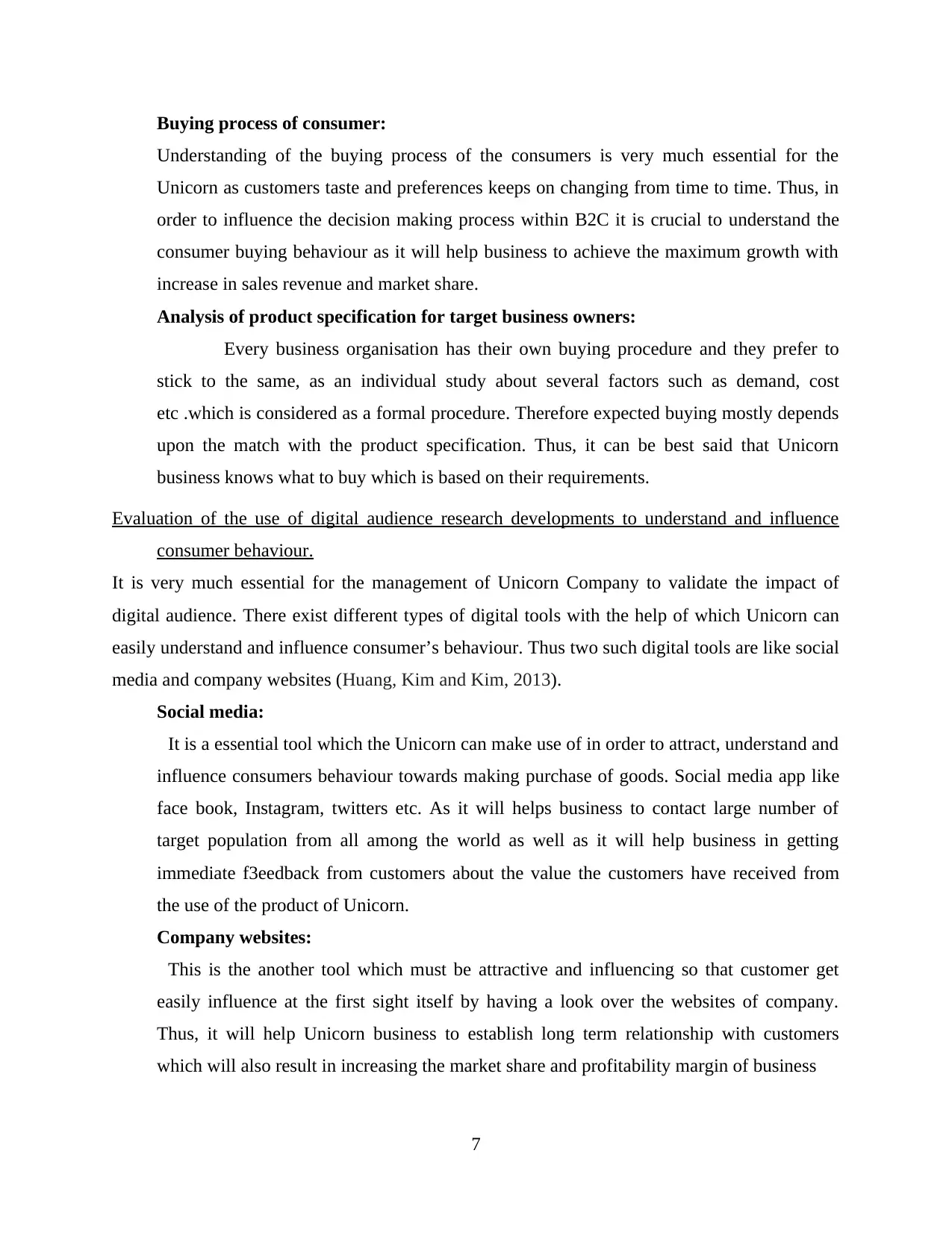
Buying process of consumer:
Understanding of the buying process of the consumers is very much essential for the
Unicorn as customers taste and preferences keeps on changing from time to time. Thus, in
order to influence the decision making process within B2C it is crucial to understand the
consumer buying behaviour as it will help business to achieve the maximum growth with
increase in sales revenue and market share.
Analysis of product specification for target business owners:
Every business organisation has their own buying procedure and they prefer to
stick to the same, as an individual study about several factors such as demand, cost
etc .which is considered as a formal procedure. Therefore expected buying mostly depends
upon the match with the product specification. Thus, it can be best said that Unicorn
business knows what to buy which is based on their requirements.
Evaluation of the use of digital audience research developments to understand and influence
consumer behaviour.
It is very much essential for the management of Unicorn Company to validate the impact of
digital audience. There exist different types of digital tools with the help of which Unicorn can
easily understand and influence consumer’s behaviour. Thus two such digital tools are like social
media and company websites (Huang, Kim and Kim, 2013).
Social media:
It is a essential tool which the Unicorn can make use of in order to attract, understand and
influence consumers behaviour towards making purchase of goods. Social media app like
face book, Instagram, twitters etc. As it will helps business to contact large number of
target population from all among the world as well as it will help business in getting
immediate f3eedback from customers about the value the customers have received from
the use of the product of Unicorn.
Company websites:
This is the another tool which must be attractive and influencing so that customer get
easily influence at the first sight itself by having a look over the websites of company.
Thus, it will help Unicorn business to establish long term relationship with customers
which will also result in increasing the market share and profitability margin of business
7
Understanding of the buying process of the consumers is very much essential for the
Unicorn as customers taste and preferences keeps on changing from time to time. Thus, in
order to influence the decision making process within B2C it is crucial to understand the
consumer buying behaviour as it will help business to achieve the maximum growth with
increase in sales revenue and market share.
Analysis of product specification for target business owners:
Every business organisation has their own buying procedure and they prefer to
stick to the same, as an individual study about several factors such as demand, cost
etc .which is considered as a formal procedure. Therefore expected buying mostly depends
upon the match with the product specification. Thus, it can be best said that Unicorn
business knows what to buy which is based on their requirements.
Evaluation of the use of digital audience research developments to understand and influence
consumer behaviour.
It is very much essential for the management of Unicorn Company to validate the impact of
digital audience. There exist different types of digital tools with the help of which Unicorn can
easily understand and influence consumer’s behaviour. Thus two such digital tools are like social
media and company websites (Huang, Kim and Kim, 2013).
Social media:
It is a essential tool which the Unicorn can make use of in order to attract, understand and
influence consumers behaviour towards making purchase of goods. Social media app like
face book, Instagram, twitters etc. As it will helps business to contact large number of
target population from all among the world as well as it will help business in getting
immediate f3eedback from customers about the value the customers have received from
the use of the product of Unicorn.
Company websites:
This is the another tool which must be attractive and influencing so that customer get
easily influence at the first sight itself by having a look over the websites of company.
Thus, it will help Unicorn business to establish long term relationship with customers
which will also result in increasing the market share and profitability margin of business
7
Paraphrase This Document
Need a fresh take? Get an instant paraphrase of this document with our AI Paraphraser
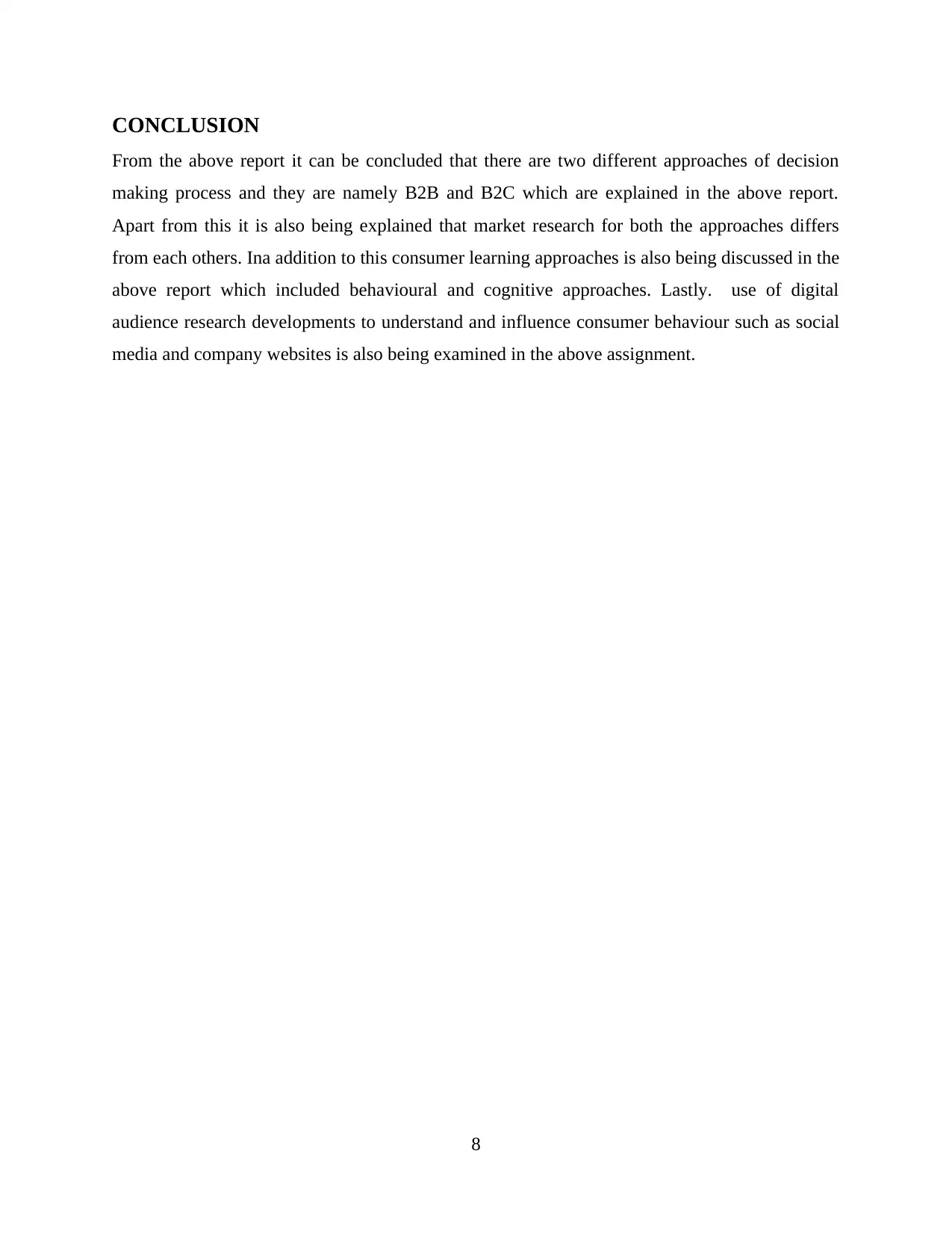
CONCLUSION
From the above report it can be concluded that there are two different approaches of decision
making process and they are namely B2B and B2C which are explained in the above report.
Apart from this it is also being explained that market research for both the approaches differs
from each others. Ina addition to this consumer learning approaches is also being discussed in the
above report which included behavioural and cognitive approaches. Lastly. use of digital
audience research developments to understand and influence consumer behaviour such as social
media and company websites is also being examined in the above assignment.
8
From the above report it can be concluded that there are two different approaches of decision
making process and they are namely B2B and B2C which are explained in the above report.
Apart from this it is also being explained that market research for both the approaches differs
from each others. Ina addition to this consumer learning approaches is also being discussed in the
above report which included behavioural and cognitive approaches. Lastly. use of digital
audience research developments to understand and influence consumer behaviour such as social
media and company websites is also being examined in the above assignment.
8
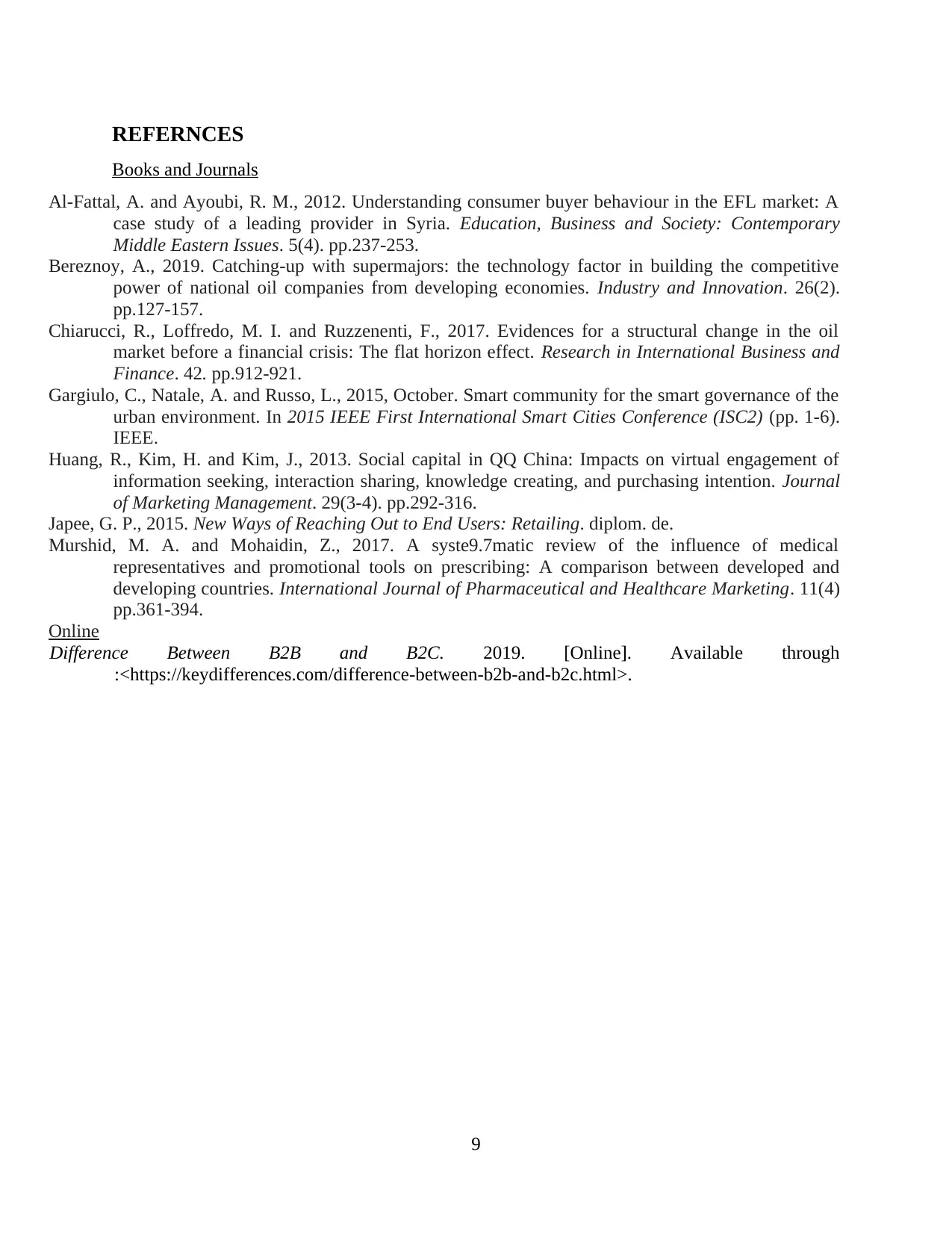
REFERNCES
Books and Journals
Al-Fattal, A. and Ayoubi, R. M., 2012. Understanding consumer buyer behaviour in the EFL market: A
case study of a leading provider in Syria. Education, Business and Society: Contemporary
Middle Eastern Issues. 5(4). pp.237-253.
Bereznoy, A., 2019. Catching-up with supermajors: the technology factor in building the competitive
power of national oil companies from developing economies. Industry and Innovation. 26(2).
pp.127-157.
Chiarucci, R., Loffredo, M. I. and Ruzzenenti, F., 2017. Evidences for a structural change in the oil
market before a financial crisis: The flat horizon effect. Research in International Business and
Finance. 42. pp.912-921.
Gargiulo, C., Natale, A. and Russo, L., 2015, October. Smart community for the smart governance of the
urban environment. In 2015 IEEE First International Smart Cities Conference (ISC2) (pp. 1-6).
IEEE.
Huang, R., Kim, H. and Kim, J., 2013. Social capital in QQ China: Impacts on virtual engagement of
information seeking, interaction sharing, knowledge creating, and purchasing intention. Journal
of Marketing Management. 29(3-4). pp.292-316.
Japee, G. P., 2015. New Ways of Reaching Out to End Users: Retailing. diplom. de.
Murshid, M. A. and Mohaidin, Z., 2017. A syste9.7matic review of the influence of medical
representatives and promotional tools on prescribing: A comparison between developed and
developing countries. International Journal of Pharmaceutical and Healthcare Marketing. 11(4)
pp.361-394.
Online
Difference Between B2B and B2C. 2019. [Online]. Available through
:<https://keydifferences.com/difference-between-b2b-and-b2c.html>.
9
Books and Journals
Al-Fattal, A. and Ayoubi, R. M., 2012. Understanding consumer buyer behaviour in the EFL market: A
case study of a leading provider in Syria. Education, Business and Society: Contemporary
Middle Eastern Issues. 5(4). pp.237-253.
Bereznoy, A., 2019. Catching-up with supermajors: the technology factor in building the competitive
power of national oil companies from developing economies. Industry and Innovation. 26(2).
pp.127-157.
Chiarucci, R., Loffredo, M. I. and Ruzzenenti, F., 2017. Evidences for a structural change in the oil
market before a financial crisis: The flat horizon effect. Research in International Business and
Finance. 42. pp.912-921.
Gargiulo, C., Natale, A. and Russo, L., 2015, October. Smart community for the smart governance of the
urban environment. In 2015 IEEE First International Smart Cities Conference (ISC2) (pp. 1-6).
IEEE.
Huang, R., Kim, H. and Kim, J., 2013. Social capital in QQ China: Impacts on virtual engagement of
information seeking, interaction sharing, knowledge creating, and purchasing intention. Journal
of Marketing Management. 29(3-4). pp.292-316.
Japee, G. P., 2015. New Ways of Reaching Out to End Users: Retailing. diplom. de.
Murshid, M. A. and Mohaidin, Z., 2017. A syste9.7matic review of the influence of medical
representatives and promotional tools on prescribing: A comparison between developed and
developing countries. International Journal of Pharmaceutical and Healthcare Marketing. 11(4)
pp.361-394.
Online
Difference Between B2B and B2C. 2019. [Online]. Available through
:<https://keydifferences.com/difference-between-b2b-and-b2c.html>.
9
⊘ This is a preview!⊘
Do you want full access?
Subscribe today to unlock all pages.

Trusted by 1+ million students worldwide
1 out of 9
Related Documents
Your All-in-One AI-Powered Toolkit for Academic Success.
+13062052269
info@desklib.com
Available 24*7 on WhatsApp / Email
![[object Object]](/_next/static/media/star-bottom.7253800d.svg)
Unlock your academic potential
Copyright © 2020–2025 A2Z Services. All Rights Reserved. Developed and managed by ZUCOL.





